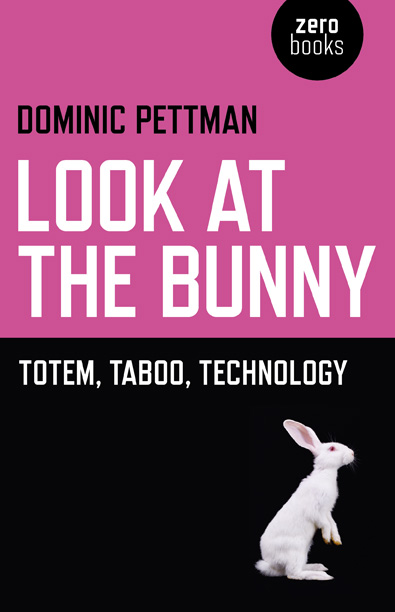Look at the Bunny
An essential guide to those technological totems and taboos which help us navigate the chaotic terrain of today's mediascape.

An essential guide to those technological totems and taboos which help us navigate the chaotic terrain of today's mediascape.
An essential guide to those technological totems and taboos which help us navigate the chaotic terrain of today's mediascape.
Criticism, Media studies
Are totems merely a thing of the distant past? Or might it be that our sleek new machines are producing totemic forces which we are only beginning to recognize?
This book asks to what degree today's media technologies are haunted by a Freudian ghost, functioning as totems or taboos (or both). By isolating five case-studies (rabbits in popular culture, animated creatures that go "off-program," virtual lovers, jealous animal spirit guides, and electronic paradises), Look at the Bunny highlights and explores today's techno-totemic environment. In doing so, it explores how nonhuman avatars are increasingly expected to shepherd us beyond our land-locked identities, into a risky - sometimes ecstatic - relationship with the Other.
In-depth podcast interview with the author: http://newbooksinscitechsoc.com/2013/05/31/dominic-pettman-human-error-uminnesota-2011look-at-the-bunny-zero-books-2013/
Click on the circles below to see more reviews
This uses the rabbit as totem as a trope through which to interrogate our relationship with technology. Pettman explores the Heideggerian being-toward-death of the pooka in Harvey (1950) and Donnie Darko (2001), the overwrought sexuality of Who Framed Roger Rabbit? (1988), and the spectral haunting of the rabbits in David Lynch’s Inland Empire (2006). Like Frank the bunny in Donnie Darko, Pettman reads the rabbits both Of Mice and Men and Watership Down as guides: Looking at the bunny is looking into the future. Skipping ahead, however, is not always a promising prospect. The Cassandra conundrum of seeing imminent catastrophe and having no one in the present believe you follows the prophet–rabbit or otherwise. The vagabond rabbits of Watership Down led by the frequently hysterical Fiver, Lennie, George, and Candy in Of Mice and Men led by a rabbit-ridden future vision, Donnie Darko led by his daylight hallucinations of Frank, and Elwood led by his imaginary Harvey are all held suspect by their peers. ”The list of lapine totems, no doubt, could go on and on–which is partly my point,” he writes (p. 63). Moreover, two more rabbit holes Pettman mentions early in the book include “the bunny plot” and “the Easter egg.” The former is a nagging idea that won’t leave you alone until you write it out of there, and the latter, of course, refers to the hidden treats of media: DVD menus, websites, etc. Pettman writes, Indeed, the notion of the Easter egg can be employed to reflect on the nature or possibility of significant surprises in a claustrophically overcoded – thus predictable – world. A world seemingly bereft of alternatives. Perhaps we need to enact rituals designed to encourage the magic bunny to break the tedious cultural algorithms that restrict every day – in the West at least – to a smooth series of anticipated rhythms. (After all, a predictable consumer is a docile and productive citizen.) Perhaps we should be finding inspiration from the temporal tricks of this particular totem to get access not to the material Easter eggs of fetishized commodities, but the hidden, virtual gift of the “something else”: an unprecedented experience, a unimagined possibility, an unanticipated alliance, and so on (p. 63). Make no mistake, this rabbit hole is deep. A future seen eliminates the element of surprise. For the living being, it’s an ontological issue, one that Pettman explores from virtual rabbits to software, citing everyone from Eugene Thacker, McKenzie Wark, William Gibson, Marshall McLuhan, and N. Katherine Hayles, to Slavoj Žižek, Deleuze and Guattari, Vilém Flusser, and Giorgio Agamben. Make no mistake, this rabbit hole is deep. Concluding, Pettman sums it up, writing, The rabbit, Orc, penguin, avatar, angel, pixelated lover – even Paradise itself – all make appearances in the idiosyncratic virtual montage fashioned by this book. They are neototems for an era in which the monolithic notion of Nature is finally giving way to an understanding of ecology that includes computers as much as whales, and in which humans are just as likely to be sheep as shepherds (p. 164). Far from the private life of the rabbit, its many public representations can show you the way. Totems can help us see the world with fresh eyes. So, next time you’re lost in the media matrix, wake up and follow the rabbit. ~ Roy Christopher, http://roychristopher.com/look-at-the-bunny
Reading Dominic Pettman doesn't change what one thinks. It changes HOW one thinks. What starts out as counter-intuitive ends up as so true and right that one can no longer recall ever thinking otherwise. This book is only for those courageous enough to venture down the rabbit-hole. ~ Jodi Dean, author of Blog Theory and Democracy and Other Neoliberal Fantasies.